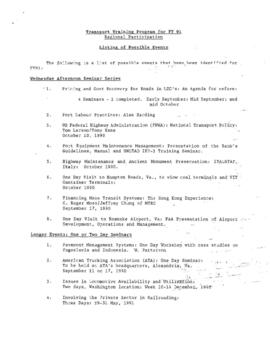Identity area
Reference code
Title
Date(s)
- 1952 - 1953, 1964 - 1991, 2001 - 2011 (predominant 1968 - 1991) (Creation)
Level of description
Fonds
Extent and medium
143.93 linear feet of textual records and topographic maps; 50 photographs; 27 computer disks
Context area
Name of creator
Biographical history
Sector departments were created as part of a World Bank-wide reorganization in 1972. The sector departments were responsible for: improving and maintaining the quality of Bank lending and related operations through sector policy and guideline development; support and review of operations; recruitment assistance; staff development and training; and liaison with external organizations. Sector departments were generally not responsible for leading project lending operations and member country relations. The Bank's projects and member country relations were instead the responsibility of regional vice presidencies (RVPs). See the related units of description note for more information.
The Bank's transportation sector work began in the Economic Department (created April 19, 1948) and the Technical Operations Department (TOD) (September 1952 to January 18, 1965). These departments had similar responsibilities for operational and sector work, providing expertise and assistance for projects and studies. Departments were structured geographically; there were no specific units assigned to different sectors.
The Bank's first loan supporting transportation was a component of the Bank's first loan to France for post-war reconstruction in May 1947. The loan funded the purchase of locomotives and freight cars, cargo ships and canal barges, and commercial airplanes. The first standalone transportation project financed by the Bank was the Railway Project - India - P009588, approved in 1949 for the rehabilitation and development of railways. This was also the first loan to India and to an Asian nation.
1965 - 1972
A reorganization of TOD resulted in the creation of the Projects Department (PRJ) on January 18, 1965. PRJ was responsible for the identification, appraisal, and supervision of projects, as well as policy formulation, research, and advice in support of the operational activities of the Area Departments. A separate transportation sector unit was first articulated in the Bank's organizational chart as a lower division of PRJ, the Transportation Division (PRJTP). Other divisions subordinate to PRJ were: Agriculture Division (PRJAG); Education Division (PRJED); Public Utilities Division (PRJPU); and Industry Division (PRJIN).
On November 1, 1968, the Projects Department was terminated and the subordinate divisions were upgraded to the department level. The Transportation Department (TRP) was one of the newly created departments along with the Departments of Agriculture (AGP), Education (EDP), and Public Utilities (PBP). At the time it was created, the Transportation Department was organized into seven divisions: Highways Division I (TRPM1), Highways Division II (TRPM2), Highways Division III (TRPM3), Ports and Pipelines Division (TRPP1), Railways Division (TRPR1), Urban Transport and Aviation Division (TRPUA), and the General Economics and Pre-Investment Division (TRPPR). A number of divisional reorganizations occurred over the subsequent four years, but no significant responsibility was added or taken away.
From 1968 until a Bank-wide reorganization in 1972, the individual Projects Departments reported to the Director, Projects (DRP), and were the primary Bank units responsible for the appraisal, negotiations, and supervision of operational project work in their respective sectors. The Departments were specifically responsible for:
-
providing advice, conducting research, and monitoring developments in sector issues;
-
carrying out sector studies with the objective of identifying projects and determining priorities within sectors;
-
preparing policy papers outlining the basic principles and approaches of the Bank relating to project and sector work;
-
preparing guidelines and standards;
-
appraising proposed projects and supervising projects in execution;
-
assisting in the identification and preparation of projects;
-
providing operational support in the negotiation and administration of loans and credits;
-
cooperating with other international agencies on programs of common interest.
TRP initiated a study in 1969, the Highway Design and Maintenance Standards Study (HDMS), in response to the need for an effective road transportation network to strengthen economic and social development and minimize total costs of road networks. The initiative became a large-scale program of collaborative research with leading research institutions and road agencies in several countries.
1972 - 1986
The Bank's massive reorganization in October of 1972 attempted to more effectively fuse country knowledge and sector skills. Sectors with a sufficient number of experts and an established lending program, such as the Transportation Department, were largely decentralized. While maintaining a centralized core staff of Department advisors, the majority of Department staff was dispersed to regional project departments in newly established regional vice presidencies. The remaining centralized staff made up the sector operating departments and performed advisory services for the regions. They were responsible for improving and maintaining the quality of Bank lending and related operations through: formulating policies, methodology and guidelines; providing operational support and advice; and managing related programs of recruitment assistance, staff development and education. Some departments, which had only a small number of staff, remained completely centralized and retained operational responsibilities; they were referred to as centralized operating projects departments (COPD).
The Transportation Department, as well as other sector operating departments, reported to the newly created vice president, Central Projects (CPSVP); the vice president, Central Projects, replaced the previous director, Projects (DRP), and reported to the senior vice president, Operations (SVPOP). The centralized operating projects departments also reported to the vice president, Central Projects. On October 1, 1973, the Transportation Department was merged with the Urban Projects Department (UBP) to form the Transportation and Urban Projects Department (TRU). The department continued to report to the vice president, Central Projects. Transportation Projects continued to function as a sector department, performing only advisory services for the Regions at their request and also formulating policies and quality control. The department's urban project functionality continued to act as a centralized operating projects department. The department maintained a Transport Research Division (TRURS) as well as two urban-related divisions. On February 1, 1976, a third urban-related operational division in anticipation of an expanded role for the department.
On June 1, 1976, the transport and urban functions were separated and re-established as independent departments as a result of the Urban Projects Department's (RB) designation as lead and coordinator of the Bank-wide initiative against urban poverty. The transportation function would be organized within the independent Transportation Department(TRP). It continued to operate as a sector department and briefly maintained its single division, the Research Division (TRPRS) and its Front Office advisory staff. However, in October, 1976, the Research Division was terminated and the Front Office advisory staff reorganized into five units: Ports and Aviation Advisory Unit, Highway Design and Maintenance Advisory Unit, Railways and Finance Advisory Unit, Regional Advisory Unit, and Standards and Procurement Advisory Unit.
During this period, a sector policy paper on Urban transport was published in May 1975. The paper describes the concerning situation of urban transport in developing countries, particularly in the poorer city districts, with respect to inadequate public transportation in rapidly growing cities, severe congestion, and poor road surfaces. It recommends an approach for the Bank's future lending with an emphasis on low-cost public transport including rehabilitation and expansion of bus and urban rail systems and facilities for bicycle tracks, pedestrian pathways, and commercial traffic.
On July 1, 1979, the water supply and telecommunications functions of the former Energy, Water and Telecommunications Department (EWT) were combined with the transportation function to form the new Transportation, Water and Telecommunications Department (TWT). The department reported to the vice president, Central Projects (CPSVP). In taking on telecommunications operational responsibilities, the department became a sector and central operational projects department: combining advisory, policy making and operational functions. On the date of its establishment, the department was assigned four divisions: a Transportation Advisory Unit (TWTTR) along with a Telecommunications Division (TWTTL), a Front Office Advisory Staff (TWTDR), and a Water and Wastes Advisory Unit (TWTWW). A construction industry (CI) adviser was also added around 1979.
In March of 1982, the telecommunications function of the Department was moved to the newly established Industry Department (IND), leaving the transportation and water functions to form the Transportation and Water Department (TWD). It reported to the newly created Vice President, Operations Policy (OPSVP). At the date of its establishment the Department had no formal divisional structure, but only Advisory Units for Transportation (TWDTR) and for Water and Wastes (TWDWW).
In January, 1983 TWD published a working paper, Sector Support Strategy Paper - Transportation that assessed Bank activity in the sector, outlining overall Bank strategy in transportation and developing a plan for support to the Regions.
On July 1, 1983, the Transportation and Water Department again became the Transportation Department (TRP), after the transfer of the water supply functions to the renamed Water and Urban Development Department (WUD). The Transportation Department, headed by Louis Y. Pouliquen, continued to report to the vice president, Operations Policy (OPSVP). At the date of its establishment, the department had no formal divisional structure. It had a Front Office advisory staff reporting to the senior advisor.
1987 - 1996
On July 1, 1987, a Bank-wide reorganization resulted in the termination of almost all organizational units. A new department, the Infrastructure and Urban Development Department (INU), incorporated the previous Water Supply and Urban Development Department and Transportation Department, and was placed in the Sector Policy and Research Vice-Presidency (PRE, then, beginning on January 1, 1990, the PRS). The departments of the Sector Policy and Research Vice Presidency had no responsibility for managing operational activities but, rather, focused on operational support, the formulation of Bank-wide sector policies and overseeing the ex post evaluation of Bank-wide sector work and lending. The units within the PRE concentrated on policy creation and analysis, support for operations and sectoral research for emerging priority areas of the Bank. At the time of its establishment, the Infrastructure and Urban Development Department had the following divisions: the Transport Development Division (INUTD), the Water and Urban Development Division (INUWD) and the Infrastructure Strategy, Management and Assessment Division (INUIS). In 1988, the Transport Development Division was renamed the Transport Division, but retained the same acronym.
The Transport Division performed the following activities:
-
developing, in consultation with the Regions, priorities for research and policy on key issues in the transport sector;
-
conducting policy analyses, research, external liaison, operational support, and related environmental quality enhancement activities on various economic, institutional and management issues;
-
advising on transport issues in the design of country strategies, and in adjustment and sector operations; providing operational support to strengthen links among research, policy and projects;
-
reviewing annual performance of Bank operations in the transportation sector;
-
disseminating research results and policy studies for the sector and organizing and conducting appropriate training seminars on emerging issues in the sector; and
-
maintaining contacts with the academic community worldwide.
In 1989, INUTD published a report, Transport Sector Review that examined the Bank's experience with implementing transport sector lending operations and presented suggestions for improving sector lending.
On December 1, 1991, President Lewis Preston's first reorganization abolished all Senior Vice-Presidencies. The new Sector and Operations Policy Vice Presidency (OSPVP) was created and adopted functions previously supervised by senior vice presidents, including the Infrastructure and Urban Development Department. On January 1, 1993, as part of a larger initiative to align the Bank's organization with the priority areas of its poverty reduction effort, OSPVP was terminated. All research activities were removed from the departments in the Central Vice Presidencies, including INF, and were consolidated under the Chief Economist and Vice President for Development Economics (DECVP). The Policy Research Department (PRD) under DECVP became the principal research arm of the Bank.
OSVP was replaced by the three new thematic vice presidencies: Human Resources Development and Operations Policy (HRO), Finance and Private Sector Development (FPD), and Environmentally Sustainable Development (ESD).
The newly created Transportation, Water, and Urban Development Department (TWU) was organized within the Environmentally Sustainable Development (ESD) Vice Presidency alongside three other sector or thematic departments: the Agriculture and Natural Resources Department (AGR), Environment Department (ENV), and the Consultative Group for International Agricultural Research (CGIAR) Secretariat. TWU had the following divisions: the Transportation Division (TWUTD), the Urban Development Division (TWURD), the Water and Sanitation Division (TWUWS), and the UNDP/World Bank Water and Sanitation Program (TWUWU). Divisional structure remained unchanged until 1997.
Each Sector Department was responsible for the following:
-
preparing policies, guidelines, standards, handbooks and analytical tools relevant to the sector;
-
identifying, codifying and disseminating best practices and lessons of experience, and evaluating weaknesses;
-
providing advice to the Regions as needed;
-
monitoring and tracking work in the sectors assigned in order to identify generic issues and identifying, evaluating and influencing trends and patterns;
-
performing surveys of experience and practice within the Bank and elsewhere, and develop innovative approaches;
-
participating in Bank-wideefforts to assess skill requirements, and to upgrade skills through recruitment, training, orientation, seminars, newsletters, etc.;
-
representing the Bank to external communities of interest;
-
maintaining an awareness of relevant external practices and viewpoints.
1997 - 2014
Four years later, in 1997, the thematic Vice Presidencies were reorganized by World Bank Group President James D. Wolfensohn to strike a better balance between country focus and sectoral excellence. To facilitate sharing of expertise and knowledge, the Bank established networks that linked Bank-wide communities of staff working in the same field across organizational boundaries and with external partners. The networks formed a virtual overlay on the existing Bank organization, and were intended to link staff working in the same sectors throughout the Bank, whether the staff was located in the Regions, in the Central Vice-Presidencies' Sector Departments, or other Vice-Presidencies.
Each of the three thematic Central Vice-Presidencies was transformed into the central units, or anchors, of each network and consisted of the existing sector departments. On a Bank-wide basis, sector specialists were grouped into regional sector units or into central sector departments which worked with country departments in a matrix relationship. Staff from the central sector departments could become part of the regional operational teams when their sectoral expertise was required.
Each Network Anchor had a Network Council to oversee the entire network, and sector boards covering the individual sectors within a network. The Network Council was composed of the network managers from each Region and was responsible for setting the overall agenda for the network and for promoting the effective deployment of skills across network units. Sector boards brought together the sector leaders from each Region and from the central vice presidencies. Staff from the central Sector Departments could become part of the regional operational teams when their sectoral expertise was required.
The work programs of Network staff focused on:
-
global knowledge - putting the best development knowledge in the hands of Bank task teams; ensuring that the knowledge base was accessible to external clients; and contributing to the growth of the knowledge base;
-
enhanced skills - developing and providing content to training courses; establishing professional and technical standards for professional development;
-
shared strategies - assisting regional and central units to develop a common sector agenda, and ensuring that skills are effectively deployed across the entire network. Network leadership assumed responsibility for global programs, sector strategy development and evaluation, strategic partnerships, and learning and dissemination;
-
best teams and best practices - improving the Bank's flexibility and mobility by building stronger task teams and delivering higher quality products;
-
institutional initiatives - providing substantial support for new Bank-wide initiatives, such as Social Development, Rural Development, Financial Sector, Anti-corruption, Human Resources, and Knowledge Partnerships.
The result of the 1997 restructuring was four networks: the Environmentally and Socially Sustainable Development Network (ESSD); the Finance, Private Sector Development, and Infrastructure Network (FPD); the Human Development Network (HDN); and the Poverty Reduction and Economic Management Network (PRM). The Transportation, Water and Urban Development Department (TWU) retained its name and component parts and was situated within the Finance, Private Sector Development, and Infrastructure Network (FPSI). TWU units included the Transport Division (TWDTD), Urban Development Division (TWURD), Global Urban Unit (TWUGL), Water and Sanitation Division (TWUWS), UNDP/WB Water and Sanitation Program (TWUWU), and the regional water program units, all reporting to the Office of the Director (TWUDR).
In early 1999, President Wolfensohn announced the need for greater integration of Bank operations and its International Finance Corporation (IFC) affiliate, which specialized in private sector development advisory and investment services. As a result, in February 1999, FPSI was terminated in place of the joint World Bank and International Finance Corporation (IFC) Private Sector Development and Infrastructure Development Vice Presidency (PSIVP). Functions and staff from PSD, EMT, and TWU departments of FPSI were transferred to the new PSIVP and the Project Finance and Guarantees Department (PFG)was also mapped into PSIVP. The Transportation Department again retained its name and component parts in PSIVP.
INF was soon dissolved following another reorganization effective July 1, 2001 that created the Energy and Water Department (EWD) and the Transport and Urban Development Department (TUD). EWD and TUD were not joint Bank and IFC departments and continued to report to PSIVP. TUD, led by Director John Flora, contained the following units: Transport (TUDTR); Urban (TUDUR); Disaster Management Facility (TUDDM); and Cities Alliance Program (TUDCA).
In May 2003, a subsequent reorganization terminated PSIVP and split its functions and staff among the new joint IFC and World Bank Private Sector Development Vice Presidency (PSDVP) and the Bank's Infrastructure Network (INF). The Oil, Gas, Mining, and Chemicals Department (COC), Global Information and Communications Technologies Department (CIT), EWD, and TUD were mapped into the INF Network. Maryvonne Plessis-Fraissard was appointed director, TUD. By 2005, TUD divisions included: Transport (TUDTR); Urban (TUDUR); Hazard Management (TUDHM); and Cities Alliance Program (TUDCA).
In June 2006, President Wolfowitz announced the consolidation of the former ESSD and INF Vice Presidencies into the Sustainable Development Network (SDN) with the objective of mainstreaming environmental issues, improving synergies, better integrating core operations, and strengthening focus on sustainability. SDN was operational on January 1, 2007 and the transport function was again combined with the energy and water functions to form the Energy, Transport and Water Department (ETW). Led by Director Jamal Saghir, the units included: Energy Unit (ETWEN); Energy Sector Management Assistance Program (ETWES); Transport Unit (ETWTR); Water Unit (ETWWA); and the Water and Sanitation Program (ETWWP). The urban development functionality was moved into the Finance Economics and Urban Department (FEU) which was also organized within the newly formed SDN.
The aim of the network integration in relation to the transport sector was to:
-
treat water issues more broadly by building water resource management strategies that cover agriculture, rural and urban dimensions, while linking these with energy and environment concerns;
-
integrate more systematically rural development approaches in energy, transport, or ICT projects;
-
develop a holistic approach to climate change mitigation and adaptation, expanding the work on the clean energy investment agenda.
In September 2010, restructuring of SDN separated the energy function from transport and water and the following SDN departments were created: Environment Department (ENV); Agricultural and Rural Development Department (ARD); Concessional and Sub-National Finance (CSF); Finance, Economics and Urban Development (FEU); Sustainable Energy (SEG); Social Development (SDV); and Transport, Water, and Information and Communication Technologies (TWI). TWI units included: Information and Communication Technology (TWICT); TWIFS (Financial Solutions Unit); Infrastructure Policy Unit (TWISI); Transport Unit (TWITR); Water Unit (TWIWA); and the Water and Sanitation Program (TWIWP).
2014
On July 1, 2014, a Bank-wide reorganization introduced by President Jim Yong Kim restructured the Bank into fourteen Global Practices (GPs) and five Cross-Cutting Solution Areas (CCSAs). ector staff from the regional vice presidencies were relocated to the GPs or CCSAs. The GPs were responsible for each major thematic area, which the Bank supports through projects and functions as a vertical pillar of technical expertise. As a GP located within the Sustainable Development Practice Group (GGSVP), responsibilities of the Transport and Information Technology (ICT) GP include:
-
defining the strategic direction and the Bank's work in the transport and ICT sectors;
-
delivering comprehensive solutions to client countries through environmentally and socially sustainable approaches, and;
-
capturing and leveraging knowledge in the transport and ICT industries.
Pierre Guislain was appointed senior director of the Transport and ICT Global Practice (GTIDR) and 2014. The following transport units in the GTI Global Practice were formed:
Transport - East Africa (GTI01); Transport - South East Asia and the Pacific (GTI02); Transport - Europe (GTI03); Transport - Latin America and Caribbean (GTI04); Transport - Greater Middle East and North Africa (GTI05); Transport - South Asia (GTI06); Transport - Southern Africa (GTI07); Transport - Central and West Africa (GTI08); andTransport - Central and North East Asia (GTI10).
Past transport sector directors are as follows:
1968 - 1969: Franz B. Wolf
1969 - 1970: Robert Sadove
1970 - 1972: A. David Knox
1972 - 1976: Edward V. K. Jaycox
1976 - 1983: Christopher R. Willoughby
1983 - 1995: Louis Y. Pouliquen
1995 - 1999: Anthony Pellegrini
2000 - 2001: Frannie Leautier
2001 - 2003: John Flora
2003 - 2007: Maryvonne Plessis-Fraissard
2007 - 2010: Jamal Saghir
2010 - 2014: Jose Luis Irigoyen
2014 - 2017: Pierre Guislain
2017 - 2018: Jose Luis Irigoyen
2018 - 2020: Guangzhe Chen
2020 - 2021: Binyam Reja (acting)
2022 - present: Nicolas Peltier-Thiberge
Repository
Archival history
World Bank sector departments initially forwarded their records to the Bank's centralized filing system managed by the Bank's Records Management unit. The centralized files were organized according to a Bank-wide classification system, and sector and operational files were traditionally divided into general files (or non-regional files); and operational files (country-specific or regional files). In 1972, Regional Information Service Centers (RISCs) for the new Regional Vice Presidencies were established under the general control of the Bank's Central Files Unit. Sector departments supporting the Regions were required to forward the country and regional operational project records to the appropriate RISC once the project was signed. At the same time, general files generated by sector departments on all topics not specific to a region or country were to be forwarded to the Non-Regional Information Center (NRIC, 1978 - 1987). Following the closure of the NRICs in July 1987, the records were kept at the Bank'sRecords Center until they were transferred to the custody of the Archives during the Records and Archives Management Improvement Project (RAMIP).
Most records in this fonds were transferred to the Archives between 1990 and 1995. The most recent transfer to the Archives described in this fonds was in 2014 by the new GITDR Transport and ICT Department Global Practice in accordance with approved records retention schedules.
Immediate source of acquisition or transfer
Records were transferred directly from sector units to the Archives using approved records retention and disposition schedules.
Content and structure area
Scope and content
The fonds contains records that reflect the various activities of the transport sector units including operational project support to the Regions, research, collaboration with external organizations, and participation or organization of conference, seminars, and workshops. The records were created and maintained by transport-related units beginning in the late 1960s with the Transportation Projects Department (TRP) and several successor units through to the Transport, Water, and Information and Communication Technologies Department (TWI) created in 2007.
While sector records were maintained in the Bank-wide centralized filing system from the early years of operations in the 1940s until mid-1987 and some of these records remain part of the Central Files fonds, departments often kept separate working files. It is primarily the working files of the Transport Sector that comprise the records in this fonds, along with records created after 1987 when recordkeeping responsibilities were turned over to the records-creating offices. The fonds contains a gap in the records between 1992 and 2000. The gap is likely due to the frequent organizational changes of the transport units and coexistence with other sectors in the same department or division and therefore records becoming intermingled. Chronological records of the Transportation, Water and Urban Development Department (TWU) from 1993 to 1995 are part of the Records of the Environmentally Sustainable Development Vice Presidency fonds. See the related units of description note for additional information.
An extensive volume of records in the fonds are related to the Highway Design and Maintenance Standards Model (HDMS) created in 1969 and to research projects that served as the basis for the model's creation.
Reports, working papers, memoranda, and correspondence are the most common record form. The records cover a broad range of subsectors and topics under transport development, including, but not limited to: road and highway design, management, and maintenance; rural roads; pavement performance; railway construction and modernization; maritime transport and port engineering; and aviation and air transport.
Appraisal, destruction and scheduling
Accruals
Accruals are expected.
System of arrangement
Sector records sent to the Bank's Non-Regional Information Center (NRIC) were arranged into the Bank-wide classification system and contained records related to more than sector, reflecting departmental responsibility for multiple sectors over time. The records of these departments were arranged in the Records of the Senior Vice President of Operations WB IBRD/IDA WB_IBRD/IDA_106 fonds, whom the departments reported to. See the related units of description note.
Original order of the records has been maintained.
Conditions of access and use area
Conditions governing access
Records are subject to the World Bank Policy on Access to Information.
Conditions governing reproduction
Records are subject to the World Bank Copyright Policy.
Language of material
- English
- French
- Portuguese
- Spanish
Script of material
Language and script notes
Physical characteristics and technical requirements
Finding aids
Allied materials area
Existence and location of originals
Existence and location of copies
Related units of description
Notes area
Alternative identifier(s)
Access points
Subject access points
Place access points
Name access points
Genre access points
Description control area
Description identifier
Institution identifier
Rules and/or conventions used
Internal World Bank Group Archives rules based on ISAD(G).
Disclosure status
Level of detail
Dates of creation revision deletion
7 March 2012, 29 March 2024




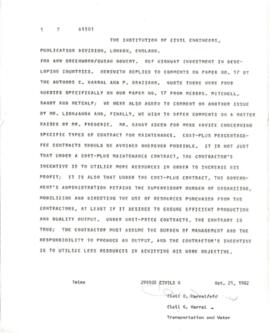
![Transport Sector Support Strategy Paper [TSSSP] - Reports - Volume 2](/uploads/r/world-bank-group-archives/c/f/6/cf61bfc3e7b347419c3e334c929087b43211de854841b15ed8e933c09b953067/WorldBankGroupArchivesFolder30349793_142.jpg)
![Transport Sector Support Strategy Paper [TSSSP] - Reports - Volume 1](/uploads/r/world-bank-group-archives/b/a/a/baa94e94a2c420f7ad371658713f55631392d06036899edc53bb6d290711fdae/WorldBankGroupArchivesFolder1157783_142.jpg)
![Conferences - Internal Road Federation [IRF] Third African Highway Conference - Abidjan - October...](/uploads/r/world-bank-group-archives/4/4/b/44b628f0ed01776fe6c3890f59c2be78f922c02e6111a647e5aa884c650dd752/WorldBankGroupArchivesFolder1157790_142.jpg)
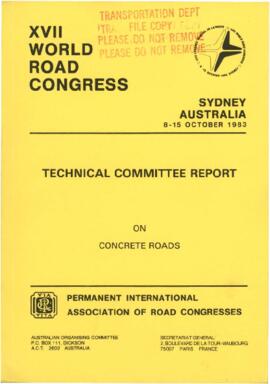
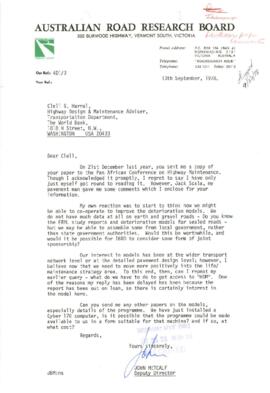

![Indonesia - Institute of Road Engineering [IRE] - Notes, Correspondence, Reports](/uploads/r/world-bank-group-archives/0/0/a/00a639a128c75891d030bb2edcedad1208fe90cba1fdfd8d40361c4fe8c3bea3/WorldBankGroupArchivesFolder1157645_142.jpg)
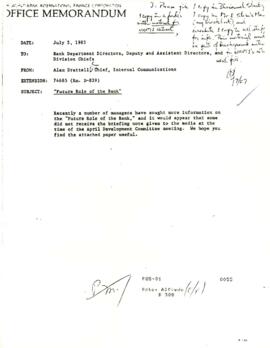
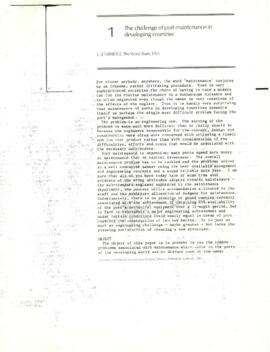
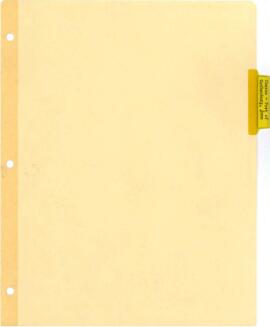



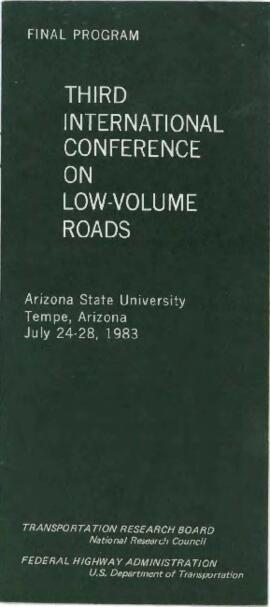
![Highway Conferences and Courses - Federal Highway Administration [FHWA] - National Highway Instit...](/uploads/r/world-bank-group-archives/8/0/1/8018524427e1531e8f93b864ced5144039ac6490aaa615bcdf8680aa348f6550/WorldBankGroupArchivesFolder30336982_142.jpg)
![USA - Highway Conferences and Courses - Strategic Highway Research Program [SHRP] - May 20-22, 19...](/uploads/r/world-bank-group-archives/3/a/7/3a7390b8b2d593656af411cd36ea4ff3705670588aa6c90b6b3d28a781c407eb/WorldBankGroupArchivesFolder30336983_142.jpg)

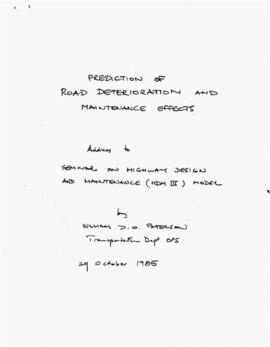
![Highway Conferences and Courses - American Society for Testing and Materials [ASTM] Symposium - D...](/uploads/r/world-bank-group-archives/5/b/5/5b5f626dbe5edcbfd5fadef9557d42d3fd8059e4516fea7ce28d9d97eccccb1e/WorldBankGroupArchivesFolder30336986_142.jpg)
![Highway Conferences and Courses - Conference on Asphalt Pavements for Southern Africa [CAPSA] - C...](/uploads/r/world-bank-group-archives/6/3/6/636bb0423714ccb698de4b2fd87194ca3a19f3976b066ea121b25731661544e2/WorldBankGroupArchivesFolder30336987_142.jpg)
![Highway Conferences and Courses - Transportation Research Board [TRB] - Notes, Meeting Informatio...](/uploads/r/world-bank-group-archives/2/9/c/29c2495b4a9f2495aa468eedcdbd6abc7d26a5b57a97fea6af21b3e389d10cdb/WorldBankGroupArchivesFolder30336988_142.jpg)
